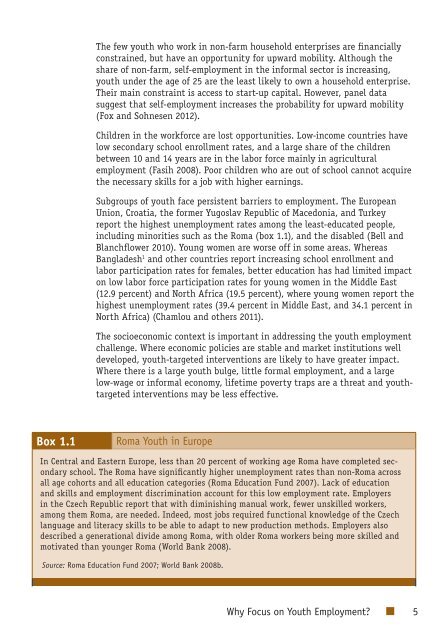Youth Employment Programs - Independent Evaluation Group
Youth Employment Programs - Independent Evaluation Group
Youth Employment Programs - Independent Evaluation Group
Create successful ePaper yourself
Turn your PDF publications into a flip-book with our unique Google optimized e-Paper software.
The few youth who work in non-farm household enterprises are financiallyconstrained, but have an opportunity for upward mobility. Although theshare of non-farm, self-employment in the informal sector is increasing,youth under the age of 25 are the least likely to own a household enterprise.Their main constraint is access to start-up capital. However, panel datasuggest that self-employment increases the probability for upward mobility(Fox and Sohnesen 2012).Children in the workforce are lost opportunities. Low-income countries havelow secondary school enrollment rates, and a large share of the childrenbetween 10 and 14 years are in the labor force mainly in agriculturalemployment (Fasih 2008). Poor children who are out of school cannot acquirethe necessary skills for a job with higher earnings.Subgroups of youth face persistent barriers to employment. The EuropeanUnion, Croatia, the former Yugoslav Republic of Macedonia, and Turkeyreport the highest unemployment rates among the least-educated people,including minorities such as the Roma (box 1.1), and the disabled (Bell andBlanchflower 2010). Young women are worse off in some areas. WhereasBangladesh 1 and other countries report increasing school enrollment andlabor participation rates for females, better education has had limited impacton low labor force participation rates for young women in the Middle East(12.9 percent) and North Africa (19.5 percent), where young women report thehighest unemployment rates (39.4 percent in Middle East, and 34.1 percent inNorth Africa) (Chamlou and others 2011).The socioeconomic context is important in addressing the youth employmentchallenge. Where economic policies are stable and market institutions welldeveloped, youth-targeted interventions are likely to have greater impact.Where there is a large youth bulge, little formal employment, and a largelow-wage or informal economy, lifetime poverty traps are a threat and youthtargetedinterventions may be less effective.Box 1.1Roma <strong>Youth</strong> in EuropeIn Central and Eastern Europe, less than 20 percent of working age Roma have completed secondaryschool. The Roma have significantly higher unemployment rates than non-Roma acrossall age cohorts and all education categories (Roma Education Fund 2007). Lack of educationand skills and employment discrimination account for this low employment rate. Employersin the Czech Republic report that with diminishing manual work, fewer unskilled workers,among them Roma, are needed. Indeed, most jobs required functional knowledge of the Czechlanguage and literacy skills to be able to adapt to new production methods. Employers alsodescribed a generational divide among Roma, with older Roma workers being more skilled andmotivated than younger Roma (World Bank 2008).Source: Roma Education Fund 2007; World Bank 2008b.Why Focus on <strong>Youth</strong> <strong>Employment</strong>? 5
















